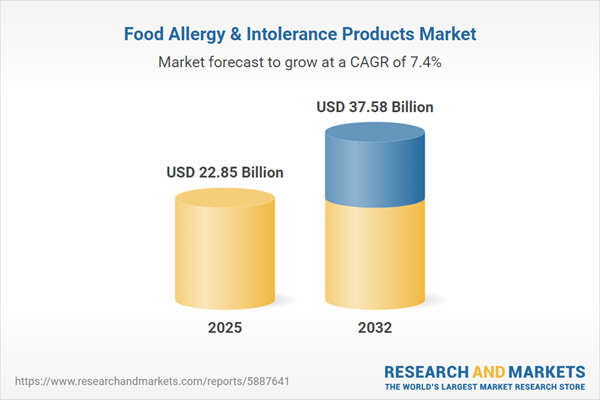Speak directly to the analyst to clarify any post sales queries you may have.
Senior executives navigating the food allergy and intolerance products market must anticipate and respond to shifting consumer attitudes and regulatory landscapes. Achieving organizational growth and preparedness requires strategic planning, compliance vigilance, and continuous innovation to address evolving dietary needs and operational complexities.
Market Snapshot: Food Allergy & Intolerance Products Market
The food allergy and intolerance products market is valued at USD 21.26 billion in 2024, with forecasts projecting expansion to USD 22.85 billion in 2025 and USD 37.58 billion by 2032. Sustained by a compound annual growth rate of 7.37%, momentum for this market is driven by heightened consumer awareness, regulatory evolution across geographies, and an increasing preference for dietary customization. Leading companies are reinforcing procurement models and implementing risk controls to adapt to dynamic supply chain trends, while ensuring that products meet compliance benchmarks on a global scale.
Scope & Segmentation: Food Allergy and Intolerance Products Market
- Product Categories: Dairy, gluten, egg, nut, and soy alternatives are central, covering products such as cheese, yogurt, baked goods, and snacks aimed at meeting diverse consumer nutritional needs.
- Distribution Channels: Market access is expanded through supermarkets, hypermarkets, convenience stores, specialty retailers, pharmacies, and e-commerce platforms, addressing both mainstream and niche audiences.
- Ingredient Sources: Sourcing involves plant-based and animal-derived components, with a focus on allergen contamination prevention, nutritional integrity, traceability, and labeling compliance.
- Form Factors: Liquid, powder, and solid product formats contribute to operational flexibility, with tailored packaging to suit various consumption preferences and streamline logistics.
- Age Groups: Dedicated lines target infants, children, and adults, enabling brands to meet specific demographic needs through optimized nutrition profiles and packaging solutions.
- Regional Segments: The market operates across the Americas, Europe, Asia-Pacific, and the Middle East & Africa, with adaptation to regional regulations and consumer behaviors, notably in China, India, Japan, and Australia.
- Key Technologies: Advanced protein extraction, fermentation, digital diagnostics, blockchain-enabled supply tracking, and evolving allergen detection techniques underpin efficiency and safety improvements across the sector.
- Company Coverage: Industry strategies and competition are shaped by leading organizations such as Danone S.A., Nestlé S.A., Abbott Laboratories, Reckitt Benckiser Group plc, The Hain Celestial Group, General Mills, Conagra Brands, Kerry Group, Ingredion, and DuPont de Nemours.
Key Takeaways for Senior Decision-Makers
- Comprehensive traceability and transparent sourcing practices enhance compliance and foster trust with stakeholders throughout the value chain.
- Incorporating fermentation and digital diagnostics facilitates rapid response to consumer dietary changes and evolving food safety standards.
- Standardizing allergen labeling and verification processes limits reputational risk and prepares organizations for shifting legislation.
- Diversified channel strategies spanning direct-to-consumer, specialty retail, and e-commerce generate insights into consumption patterns and broaden commercial opportunities.
- Building supplier partnerships across varied geographies strengthens resilience, reducing vulnerability to interruptions or policy unpredictability.
- Developing product formats and packaging tailored for specific age groups supports penetration in established and emerging markets, reinforcing long-term brand loyalty.
Tariff Impact: Adapting Sourcing and Cost Structures
Leadership teams in the food allergy and intolerance products market are adapting to recent U.S. tariff adjustments affecting dairy alternatives and specialty protein imports. This has prompted a shift toward nearshoring, expanded in-house production, and diversified supplier relationships to minimize exposure to regulatory risks and maintain consistent supply chain performance under uncertain policy conditions.
Methodology & Data Sources
This analysis incorporates secondary market data, in-depth executive interviews, and continuous monitoring of regulatory updates. Insights from senior industry stakeholders provide additional depth, ensuring guidance aligns with the strategic priorities of C-level decision-makers.
Why This Report Matters
- Presents a clear overview of market dynamics, supporting strategic planning for executive teams managing food allergy and intolerance product portfolios.
- Enables benchmarking and risk management efforts tailored for the realities of a changing regulatory environment.
- Prepares leadership to proactively navigate compliance requirements and adapt offerings to address consumer dietary and safety expectations in varied markets.
Conclusion
Senior executives can use this report to anticipate operational and regulatory shifts, enhance strategic risk management, and strengthen their organization’s ability to deliver sustained value in the evolving food allergy and intolerance products market.
Additional Product Information:
- Purchase of this report includes 1 year online access with quarterly updates.
- This report can be updated on request. Please contact our Customer Experience team using the Ask a Question widget on our website.
Table of Contents
3. Executive Summary
4. Market Overview
7. Cumulative Impact of Artificial Intelligence 2025
Companies Mentioned
The companies profiled in this Food Allergy & Intolerance Products market report include:- Danone S.A.
- Nestlé S.A.
- Abbott Laboratories
- Reckitt Benckiser Group PLC
- The Hain Celestial Group, Inc.
- General Mills, Inc.
- Conagra Brands, Inc.
- Kerry Group PLC
- Ingredion Incorporated
- DuPont de Nemours, Inc.
Table Information
| Report Attribute | Details |
|---|---|
| No. of Pages | 193 |
| Published | November 2025 |
| Forecast Period | 2025 - 2032 |
| Estimated Market Value ( USD | $ 22.85 Billion |
| Forecasted Market Value ( USD | $ 37.58 Billion |
| Compound Annual Growth Rate | 7.3% |
| Regions Covered | Global |
| No. of Companies Mentioned | 11 |









